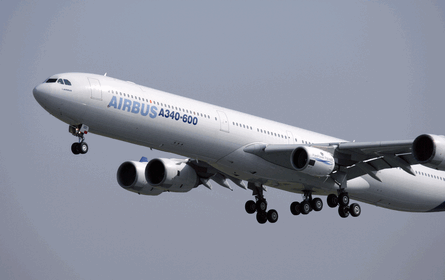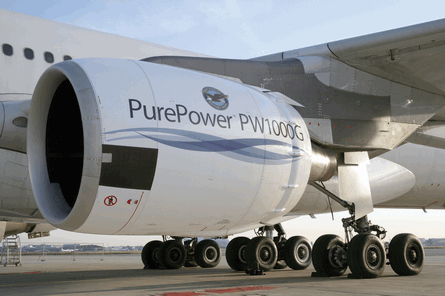European airframer gets in early on future engine technology by studying P&W turbofan on A340 flying testbed
In an event unprecedented in its 38-year history, Airbus is flight-testing a powerplant that currently has no application on any of its products - Pratt & Whitney's GTF geared turbofan demonstrator.
"This is the first time we have put a prototype engine on one of our flying testbeds," says Airbus's Philippe Abrial, who is the GTF integrated project team leader. He says that Airbus's motivation for testing the GTF "was to anticipate all the development issues we would have with such a type of engine and to assess its benefits and special characteristics when we integrate it into an airframe".
 |
|---|
© AirbusThe A340-600 trial enables P&W to test its GTF demonstrator engine alongside current generation turbofans - Rolls-Royce Trent 500s |
Abrial says Airbus "wanted to identify the effects when we integrate the engine into an aircraft and ensure that we would not encounter any major issues or constraints when we put this type of technology on to an airframe. We also wanted to evaluate the engine's acoustics and the performance from a component point of view to get advanced data to prepare for a future product."
The trial gives P&W the chance to test the engine on an airframe powered by current-generation powerplants - Rolls-Royce Trent 500s - rather than the 1970s-era P&W JT9Ds that equip its in-house Boeing 747SP flying testbed (FTB). The Trent 500s on Airbus's A340-600 FTB provide a better benchmark in terms of noise and performance than the old JT9Ds.
The GTF took to the air in the No 2 position on Airbus's A340-600 FTB on 14 October, having completed 56h in the air on the 747SP. Initial flight tests on the 747SP began on 11 July and before that, the GTF demonstrator completed 250h of ground testing at P&W's sea level test-cell facility in Florida.
 |
|---|
© AirbusThe GTF went straight off the wing of P&W's Boeing 747SP testbed on to Airbus's A340-600 |
The Airbus GTF programme is due to run to the end of 2008 and accumulate around 75h. To date the demonstrator has accumulated more than 55h of testing on the A340 during 18 flights, plus a further 9h of ground tests while installed on the Airbus. "The engine went directly off the wing of our 747 on to the wing of the A340 with no changes or modifications," says Bob Saia, vice-president P&W's next-generation product family.
MAKING CONNECTIONS
Both Abrial and Saia concur that the installation on to the A340 went "very well", although Saia adds that it took "a little longer than we thought to get all the instrumentation properly connected". The GTF has around 2,000 pieces of experimental instrumentation measuring temperature, pressure, etc, Saia says.
Airbus is also using the GTF trial to evaluate a new engine anti-ice system. "We have manufactured the air inlet for the GTF's Goodrich-built nacelle, and we have taken the opportunity to test an advanced technology pneumatic anti-ice system," says Abrial.
The initial 27h of tests on the A340, which examined the engine's performance, were completed by early November. "The object of these initial tests was to get performance data on different isolated components, which will allow us to reconcile for future products - both from P&W and Airbus," says Abrial. This involves an evaluation of how certain individual aspects of the engine - such as noise - could "extrapolate to a real aircraft", says Airbus.
Abrial reports that while it is "too early to pronounce on the test data", the operation of the GTF on the A340 has been "satisfactory, and specifically there have been no issues with its fan-drive gear system". Saia says: "So far we've met all the in-flight performance predictions".
According to P&W, the GTF demonstrator on the A340 has flown up to 37,000ft (11,300m) and Mach 0.85. The combination is expected to ultimately fly as high as 40,000ft.
Full stabilised engine performance testing has been undertaken, involving holding the aircraft in level flight at various altitudes and throttling the GTF to various power settings while the remaining three engines are adjusted in power to keep the aircraft in level flight. "We then record data on GTF after a couple of minutes to enable it to stabilise in temperature and pressure. We do that over a series of data points to understand engine performance as function of altitude, Mach number and power," he says.
The engine's handling characteristics have been examined during a series of tests flown with the aircraft at extremes of its flight envelope - for example at high altitude and low speed, or high altitude and high speed. "We've done full power take-offs to look at characteristics such as oil temperature and make thermal measurements of components," says Saia. "This data enables us to optimise the production product for the MRJ and CSeries engines."
The handling tests have verified the GTF's characteristics and response rate for acceleration, deceleration, in-flight starting and during operational manoeuvre loads - for example, at high angle of attacks, says Saia. "The geared system operates just like a conventional direct-drive engine. In fact the in-flight windmill starting was a little bit better than expected."
CONFIGURATION CHANGE
The A340 was briefly grounded in November to enable a configuration change to the engine ahead of the second test phase, which comprises system validation, engine thermal management evaluation and acoustics. "We have very long temperature and press probes downstream of the fan blade, which may have their own unique tones, so we have removed this instrumentation for the noise tests," Saia says. "This provides a 'product-relevant' noise signature."
The dedicated noise test campaign began on 2 December in Moron, Spain. "We've blocked out two weeks, but if we have the right weather conditions it probably only needs three or four flights," says Saia.
"These tests are very weather dependent - they can take four days or 15," says Abrial.
Saia says the focus of these trials is to measure environmental, or community noise using outdoor microphones. "We want to validate our mathematical models of the noise generated from the big, slow-moving fan," he says.
This will be a standard acoustic evaluation, involving a series of take-offs and landings. "We are recording noise signatures just like we would for the airworthiness certification process," says Saia, who adds that as Airbus's A340-600 FTB was the certification airframe for the Trent 500, it has a known noise signature with four Trents. Additionally, Airbus undertook static noise measurements of the GTF when it was in the sea level test cell.
"We have a prediction for the engine's noise based on the static measurements," says Saia. "So we'll measure the aircraft with three Trents and the GTF and the combination of the absolute noise measurement and our models of aircraft with four Trents plus the GTF isolated enables us to get a pretty accurate noise signature."
Abrial says that as the GTF's fan-drive gear system is "a new heat source", it is an area that the airframer is scrutinising "to be sure of the efficiency of the system". From a thermal management perspective, Saia says that the gear system's efficiency level is better than expected. "We're seeing lower oil temperatures both on the ground and in flight than predicted, which means that we will be able to make the heat exchangers smaller."
Once the Airbus testing is completed, the GTF demonstrator engine will return to P&W's plant in East Hartford for a thorough hardware inspection, says Saia. "We've got as much learning out of the demonstrator and have no additional test plans for this engine, so it will probably go in our museum."
Airbus will analyse the data from the test programme during the first quarter of 2009, with the target of having "a good reconciliation model" by mid-year, says Abrial.
Saia says that there are currently no discussions for any other airframer to conduct tests with the GTF demonstrator. As such P&W "can share engine data collected during the Airbus tests with any of our customers", says Saia. However, he adds: "There are certain things we're doing on the installation on their aircraft that is proprietary to Airbus."
Abrial says that the GTF test "is part of a research co-operation agreement, and we have agreements with P&W to share some data. The objective in the end is to have a shared position with P&W on the characteristics of the engine."
The next GTF engine to fly will be the production PW10000G variant for the Mitsubishi MRJ regional jet. "This engine will begin ground-testing in the late first quarter of 2010," Saia says, with the CSeries engine following in mid-year. Both engines will fly about 40-50h programmes on the 747SP FTB to accumulate data on in-flight performance and engine characteristics in early and late 2011, respectively. First flights of the MRJ and CSeries are due to follow in early and second quarter of 2012, respectively.
Source: Flight International























